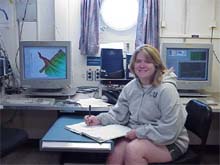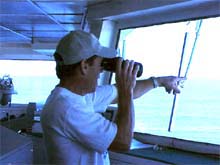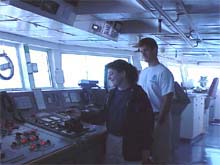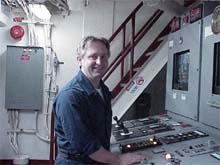
Tammie Middleton marking an event in the research log during her 12-4 pm scientific watch. During science watches we make sure that all the mapping equipment and software are running correctly. We also edit our mapping data during our watches. Click image for larger view.
"Standing Watch" Understood
September 10, 2002
Lisa M. Weiss, Watershed Coordinator
Jacques Cousteau National Estuarine Research Reserve
On a ship, watch standers are poised at key areas in the ship to ensure that ship operations are running and that our data is being collected correctly. On the Ronald Brown, there are science, engineering, deck and navigational watches. Watches run 24 hours a day, seven days a week while the ship is underway. During our trip, we run three watch schedules: 12 to 4, 4 to 8 and 8 to 12. Each watch stander takes his or her four-hour shift during both the morning hours and the evening hours. This means that people are awake and asleep at all hours of the day aboard ship.
Science Watch
Two members of the science team are on watch during all of the four-hour shifts. They are responsible for ensuring that all the seafloor mapping software and equipment is operating correctly and data is constantly being collected. Another part of watch is making sure that all of the mapping data that we have been collecting is edited.
Three monitors must be checked at 15-minute intervals. One monitor measures the number of pings that are coming back to the ship, in intervals of every 4 to 5 seconds or so. Another monitor plots the unedited seafloor mapping data in color contour intervals as it is collected. It has an image of the ship and the tracklines, and is also updated every five seconds.
Another monitor displays the 3.5 kilohertz sub-bottom profiler. This machine allows us to see beneath the seafloor. As Dr. Rona explained in the September 8th log, it helps us to understand some of the past geological events by looking at the layers of these bottom sediments. It also records depth, and a print-out by an electrostatic plotter can be analyzed after the exploration. These profiles will be used to make assumptions about the geological processes that helped shape and form both the Hudson Canyon and the areas around the canyon.

Mike Conway pointing out something ahead during his deck watch. Mike is a member of the deck crew, but during this watch period one of his assignments is to be on the lookout for any hazards to navigation such as other ships, floating debris and marine mammals. Click image for larger view.
Deck Watch
The people that stand deck watch have one of the best views from the ship. The bridge, one of the highest points on the ship, is enclosed with windows and has a 360-degree view. These watch standers are constantly on the lookout to make sure that no other ships, floating debris, stray cargo containers or marine mammals get in the way of the ship's course. They also look for flares from ships in distress. The deck watchers are trained in ship handling, so they are occasionally given the task of steering.
Another part of deck watch is to make security rounds. These are conducted two or three times every watch. They check the ship for potential smoke or fires and flooding. They also close port hole windows at night so passerby ships do not get confused by seeing numerous lights coming from the Ron Brown. In the case of poor weather or high winds, they also have to make certain that cargo on the deck is locked and secured down so it will not move all around the deck.

Officers Jenn Pralgo and Mike Hoshlyk adjusting the speed of the ship during their navigation watch. Some of the jobs during navigational watch include keeping a deck log and a marine operations abstract (MOA), checking the radar, and recording and reporting weather conditions. Click image for larger view.
Navigational Watch
The officers that stand navigational watch have a wide variety of duties. Each watch team is required to submit a deck log, or a ship's story, for what events happened during the watch. They also are required to fill out a Marine Operations Abstract (MOA) on which the ship's course, speed, latitude, longitude, depth and operations for the watch are recorded. This information is recorded in Greenwich Meantime, which is four hours ahead of our current local time off the coast of New York. This information is also plotted on both a paper chart and on electronic charts. The navigational watch has to also make sure that the ship doesn't get off track due to movement caused by weather or currents. Ship's roll (side to side tipping) can be monitored by an inclinometer on the bridge.
Navigational watchers monitor radios for ship-to-ship traffic, and they monitor the radar for other ships close to us, keeping track of their relative motion to us. They track other ships to avoid a potential collision, and to alter our course in case of an approaching vessel. Every hour, they log a weather synopsis which includes clouds, sea height, swells, water and sea temperature, and air pressure. This weather is reported to the US Marine Observation Program, the ODAS buoy Center and the Shipboard Environmental Acquisition System (SEAS) report. The officers also get weather reports from the Navy, which makes recommendations for the ship's course. A prime example of this was the recent recommendation by the Navy to seek a "safe haven" during the oncoming tropical storm Gustav. A marine safety broadcast is also sent to the ship through a NAVTECHS receiver, which is part of the Global Marine Distress and Safety System, or GMDSS.
Other responsibilities of the navigational watch officers include monitoring the ship's emergency alarm panels that ring up on the bridge. The ship is divided into zones, which are indicated by lights on the panel. If a fire alarm goes off in a particular zone, it would be displayed on this panel. The watch officer is responsible for following the correct alarm procedures when a fire is detected.

Second Engineer John Osborne during his watch. Engineers monitor the engines, generators and fuel levels. They also monitor the distribution of the ship's fuel and water supplies to ensure that the ship is balanced correctly. Click image for larger view.
Engineering Watch
The engineers monitor the equipment and machinery both within the engine room and throughout the ship. One parameter that they measure is the ship's diesel engines. The Ron Brown has six diesel engines that mechanically power six generators. The generators convert mechanical energy into electrical energy that is then supplied to the propulsion motors. When the process is reversed, electrical energy is turned back into mechanical energy to drive the propellers.
It is the duty of the engineers to turn these engines on and off as determined by the ship's speed. As the ship's speed increases, more power is required from the engines. The power that is needed to move the ship is equal to the propeller's rotations per minute (RPMs) cubed. In simpler terms, doubling the ship's speed to 30 knots would, in theory, require an eight-fold increase in the propulsion RPMs. Mechanical power generated by an engine is required when a new generator is being brought on line. The new generator must be synchronized with the currently operating generators so that there is no interruption in the power supply. These types of adjustments are computer-controlled, but the engineers still must monitor them.
The engineers also monitor the fuel used by the engines. They must keep tabs on the fuel levels in the tanks. Every four hours, fuel is transferred from the holding tanks to the day tanks where it is cleaned, making it useable by the engines. Yesterday, about 3,700 gallons of fuel were used by the Ron Brown's engines!
The engineeres must also monitor the distribution of the fuel and water supplies on the ship. As fuel and water are used, their weight to the ship must be compensated for. On the Ron Brown this distribution is directed by a saltwater ballast system, ensuring that the weight onboard the ship is parceled correctly. Weight dispersal affects the way the ship rides on the ocean. If too much weight is concentrated on one side of the ship, the ship could ride tipped to one side!
During their rounds, the engineers check the computer monitors and take readings on the engines and generators. They also take readings on the temperature of the water, oil and the fuel pressure in the engines. The engines are cooled by freshwater, which is made on the ship by evaporating saltwater. Cooled saltwater is used to lower the temperature of the freshwater surrounding the engine, using a heat exchanger to transfer thermal (heat) energy into the outgoing seawater. (This is similar to the process that fish use to distribute oxygen through their body by passing the oxygen-rich blood by the oxygen-poor blood.) Engineers also check air conditioning, the sewage pumps, and the refrigeration units throughout the ship.
Sign up for the Ocean Explorer E-mail Update List.























